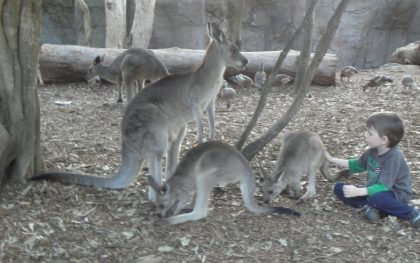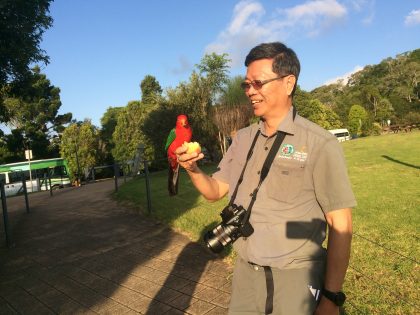General introduction

Major considerations:
- When is interaction okay and when is it not?
- Why do tourists seek interactions
- Can such interactions enhance support for conservation?
- Can we allow appropriate interactions in certain settings without encouraging inappropriate interactions elsewhere?
Interactions may be:
- Deliberate – feeding, petting or taking selfies in captivity, tourists or tour operators feeding animals in the wild, swimming with marine mammals, close approach without contact
- Unintentional – animals fed by some people expecting or demanding food from others, dangerous animals losing fear of humans and possibly stalking children, raiding of food stores or trash cans, increase of wildlife affecting local residents
Positive aspects of interactions:
- interactions – whether petting, feeding or just eye contact – can enhance a visitor’s appreciation of an animal.
- Feeding can ensure sightings and photographs for tourists short on time or not fit enough for trekking.
- Feeding can facilitate close encounters for education abut the animal
- Some tourists show little interest in animals unless they can “do” something with them
- Some find actual interaction very special and precious
- There are rare occasions where a bit of very careful assistance to wild animals by way of additional feed may be called for (but not open-slather feeding by visitors, which may make the situation much worse for those we ty to help)
Negative aspects of interactions:
- A species may increase in population numbers to the detriment of others
- Animals can be fed the wrong foods, affecting their health
- Animals gathering regularly at a site can spread diseases among themselves
- Animals may change their natural behaviour and spend less time eating natural foods
- Stress and aggression towards each other can increase with crowding in feeing areas
- Some become aggressive and even dangerous to people
- Population increases and increased boldness of handfed animals can bring them into conflict with local human residents
How do we strike a balance?

Can tourism helping solve some human/wildlife conflicts?
In farming, grazing and rural residential areas where landowners have problems with wildlife and often regard them as pests, can the tourism dollar help to mitigate serious conflicts by assisting financially with:
- appropriate fencing to separate wild predators from livestock or herbivores from crops? “Appropriate” fencing would for instance be sturdy enough to do the job, extending below the ground if necessary or netting above certain crops, but not presenting a danger to animals, such as entanglement or preventing essential movements of wildlife (e.g. between feeding/drinking/resting/breeding areas or long migration routes).
- compensation for losses by famers? This is accomplished in parts of Africa for instance, resulting in less calls for lions and leopards to be eradicated
- nonlethal deterrents around crops, gardens or domestic animals? Fires or lights at night, various sights, sounds and smells etc.
- paying farmers for access to good bird-watching or other wildlife-viewing locations on their properties?
- employing local landowners who are also wildlife enthusiasts to act as local guides
Policy: Tourist Wildlife Interactions, February 2005
Wildlife Tourism Australia Inc.
Feeding of wildlife by tourists and tourism operators
Wildlife Tourism Australia (WTA) recognises that there are many situations where feeding of Australian wildlife could cause considerable harm to humans, individual animals, populations or ecosystems, especially in wilderness areas or other relatively intact natural areas. There are other situations where appropriate feeding probably does no harm or may have a positive effect on animals and/or humans. In particular, close interaction with wild animals may well increase concern for wildlife conservation amongst many tourists.
WTA believes that wildlife in wilderness areas should be kept as fully wild as possible, and should not be fed for tourism purposes in such areas. WTA also believes that indiscriminate feeding of wildlife in any situation is unacceptable. However there are many other human activities that are far more detrimental than responsible feeding in certain non-wilderness localities. Humans and other animals have been interacting for many thousands of years, creating a continuum between totally wild animals and those whose behaviour is greatly modified by humans. These days, there is also a continuum between situations where animals are kept in close confinement for tourism purposes and those where the animals are totally unmanaged by humans. Some fluctuation in food availability due to seasonality of tourism, while potentially damaging in some situations, is not necessarily more detrimental to animals than naturally fluctuating resources (fruiting trees etc.). There are many clear-cut cases of harm caused by some feeding practices, but scientific opinion is divided as to how much is too much in other situations. The whole issue is clouded by philosophical viewpoints and personal preferences intertwined with actual ecological or welfare concerns.
Thus WTA does not take either the view of ‘never feed anything anywhere’ or the opposing view that ‘feeding can never do any real harm’. While attitudes of our members do vary, most agree that whether or not feeding of wildlife should be allowed ‘depends on the situation’. The difficulty in treading this middle road lies in determining the criteria by which we decide when, where, how and what is acceptable for feeding.
What criteria should be used to decide whether feeding of wildlife should be allowed in a particular situation?
WTA believe that feeding of wildlife by tourists or tourism operators should be permitted only in situations where ALL of the following criteria apply:
- feeding is unlikely to seriously modify the behaviour of wildlife in a natural area: e.g. feeding is in a captive setting such as a zoo or a highly-modified area such as some farm-stays; or the animals being fed have already become dependent on humans and cannot find enough food on their own (e.g. after being nursed as orphans or after an injury)
- feeding is unlikely to modify the ecosystem or community (including areas adjacent to the actual feeding area): e.g. when feeding occurs in captive situations or highly-modified habitats as above; when it does not involve highly-aggressive or predatory animals (e.g. currawongs) that might increase their population to the detriment of other species; when it does not unduly increase the populations of herbivorous animals (including seed-eaters) that may negatively impact neighbouring native plant-life
- feeding can be properly supervised and/or monitored and kept on a small scale
- visitors receive appropriate guidelines and education on the feeding of wildlife (see details below)
- appropriate foods are used: these should be prominently communicated to visitors and where possible made readily available
- the animals being fed are not likely to present a danger to humans (remembering that some which would present no danger to healthy adults may be a problem for the disabled or small children)
- humans (including both those engaging in hand-feeding and others the animals may subsequently encounter) are not likely to present a danger to the animals: e.g they are unlikely to cause spread of disease; unlikely to entice animals towards human habitation or man-made structures such as roads and car parks (which could make them susceptible to collisions with vehicles, or to become too trusting and thus vulnerable to other humans who will mistreat them); or where social disruption may result – especially separation of mother and young
- feeding does not contravene state or federal legislation pertaining to conservation or animal welfare
Importance of education
WTA believes that education of tourists and the public about the feeding of wildlife is extremely important. It should be presented in different formats for different ages, and also in different languages in areas where non-English speaking visitors are common. Because of the diversity of situations, it is difficult to find clear criteria for all situations, but what is ultimately presented to the tourist must be easy to follow. Education and interpretation should be designed to make people aware that:
- being allowed to feed animals in one situation does not mean it is acceptable to feed the same species or other species in all situations
- ‘little bits add up’ – each tourist may be one of many to feed a particular animal
- appropriate foods must be used: what is eaten by humans may not be healthy for other animals and what is appropriate for some species might not be so for others
- animals should not be given sufficient quantities of food or fed so regularly as to become dependent on human handouts
- animals should be fed in an appropriate manner (not rushing up to an animal, not sneaking up and startling it, not holding food in such a way as to invite being accidentally bitten etc.)
- animals can bite, scratch, kick etc. and should not be treated with the same lack of caution as a domesticated pet
- if animals accustomed to being fed become a serious pest or danger, they made need removing or even destroying, so what seems like a kindly act may have the reverse effect
- predatory or highly-aggressive species, if regularly hand-fed, can increase their populations to the detriment of other wildlife
- there are penalties for inappropriate behaviour towards animals (where this is in fact true)
- regular feeding of animals may disrupt their behaviour and (in addition to effects on the animals themselves) may detract from the pleasure others enjoy in seeing wild animals behaving as they have for millenia
Other forms of wildlife interaction
Other forms of wildlife interaction (e.g. swimming with seals or dolphins, walking through colonially-breeding bird colonies, or generally spending time in the presence of habituated but not food-seeking animals) can be highly rewarding for tourists, but similar concerns apply as to feeding.
WTA believes that when interacting with wildlife, visitors should either be accompanied by professional staff or educated in appropriate behaviour. Where well-run operations allow such interaction, visitors are already routinely requested not to approach animals but to allow animals to approach them if they wish. This message could also be conveyed in a variety of ways in unsupervised areas (e.g. wetlands with prolific birdlife, or camping areas with good bird life or habituated wallabies).
WTA believes that regulations limiting interaction can sometimes be detrimental to conservation. On private lands, tourist interaction with wildlife is often discouraged by governments. Consequently farmers and other landholders have no prospects of earning money from wildlife and often respond by killing them or destroying their habitat in order to facilitate farming or development. Tourists crave interaction with wildlife, yet most Australians have never seen, let alone interacted with most Australian species. It should be possible to devise more than two options for wildlife on private land: tolerated isolation or death. A third alternative is to permit appropriately managed interaction with wildlife. We suggest that it should be feasible to develop policies or guidelines based around the essential tenets of humane treatment, species preservation and the desirability of encouraging private land holders to preserve natural ecosystems.
Summary
In summary, interactions between tourists and wildlife can be valuable in fostering concern for wildlife among tourists, and provide much pleasure. However such opportunities need to be provided in such a way as to minimise negative effects on wild animals and ecosystems.
Download: WTA Policy – Tourist Wildlife Interaction (PDF)

